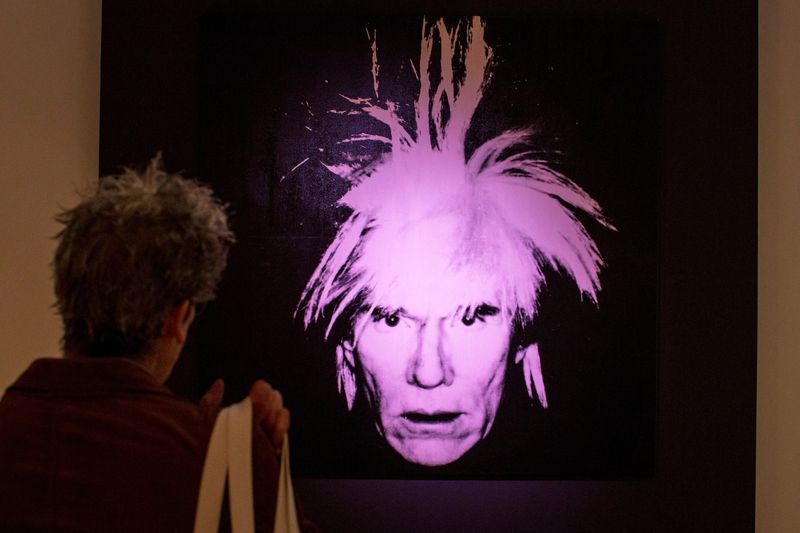By Blake Brittain
WASHINGTON (Reuters) -In lively arguments that touched on the meaning of art and referenced famous films, TV shows and paintings, U.S. Supreme Court justices on Wednesday grappled with a copyright dispute between a photographer and Andy Warhol's estate over the acclaimed artist's paintings of rock star Prince.
The court heard about two hours of arguments in a case that could help map the boundaries for artistic works that draw upon other material.
The Andy Warhol Foundation appealed a lower court's ruling that his 1984 paintings - based on a 1981 photo of Prince that celebrity photographer Lynn Goldsmith shot for Newsweek magazine - were not protected by a copyright law doctrine called fair use that allows certain unlicensed use of copyright-protected works.
A key factor courts consider for fair use is whether the new work has a "transformative" purpose such as parody, education or criticism. Some justices expressed skepticism toward the lower court's ruling that judges should not consider an artistic work's meaning in determining fair use.
"The purpose of all copyright law is to foster creativity," Justice Elena Kagan said.
"So why shouldn't we ask," Kagan added, if a work is really creative and "something new and entirely different?"
Kagan noted that a 2021 Supreme Court ruling on fair use of software cited Warhol as an "example of how somebody can take an original work and make it be something entirely different, and that's exactly what the fair use doctrine wants to protect."
Warhol, who died in 1987, was a central figure in the pop art movement that arose in the 1950s. Warhol often created silkscreen print paintings and other works inspired by photos of celebrities including Marilyn Monroe and Elvis Presley as well as consumer products, work with considerable artistic and monetary value.
He made 14 silkscreen prints and two pencil illustrations inspired by Goldsmith's photograph.
Chief Justice John Roberts said Warhol's work "sends a message about the depersonalization of modern culture and celebrity status."
"It's a different purpose" from the photo, Roberts said. "One is a commentary on modern society; the other is to show what Prince looks like."
MONA LISA AND 'JAWS'
The arguments referenced various artistic creations, some adapted and some not. These included Leonardo da Vinci's 16th century Mona Lisa painting, the 1975 film "Jaws," the 1970s and 1980s TV shows "All in the Family" and "The Jeffersons," Dutch artist Piet Mondrian's 20th century abstract paintings, the "Lord of the Rings" books and films, and even Syracuse University sports merchandise.
Some justices worried about the stakes for the creators of material that inspires other works, suggesting that their eventual ruling, due by the end of June, would take that into account.
The case could have broad implications for artists as well as the entertainment industry. The justices pondered whether Warhol's use of Goldsmith's work was more like a film adaptation of a book, which normally requires a license.
"I think moviemakers might be surprised by the notion that what they do can't be fundamentally transformative," Kagan said. "So why is it that we can't imagine that Hollywood could just take a book and make a movie out of it without paying?"
Justice Clarence Thomas noted that he was a Prince fan in the 1980s.
"No longer?" Justice Kagan interjected mischievously.
"Well, only on Thursday night," Thomas responded to laughter from the audience.
"But let's say that I'm also a Syracuse (Orange) fan and I decide to make one of those big blowup posters of (Warhol's) 'Orange Prince,'" and "put 'Go Orange' underneath. Would you sue me?" Thomas asked the estate's lawyer Roman Martinez.
Goldsmith, 74, has said she learned of Warhol's unlicensed works only after Prince's 2016 death. She countersued Warhol's estate for copyright infringement after it asked a Manhattan federal court to rule that his works did not violate her rights. A judge found Warhol's works were protected by fair use, having transformed the "vulnerable" musician seen in Goldsmith's work into an "iconic, larger-than-life figure."

The Manhattan-based 2nd U.S. Circuit Court of Appeals reversed that ruling last year.
The Supreme Court has not ruled on fair use in art since 1994, when it found that rap group 2 Live Crew's parody of singer Roy Orbison's "Oh, Pretty Woman" made fair use of the 1960s song.
